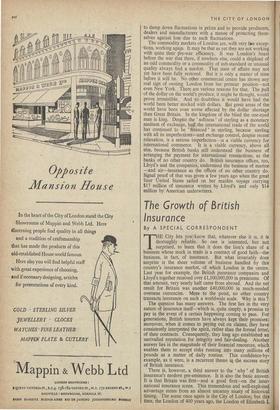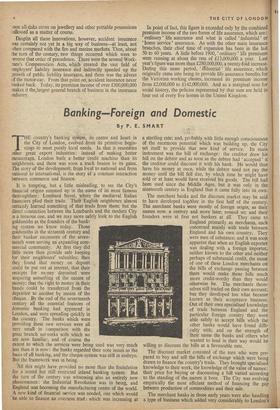The Growth of British Insurance
13,y A SPECIAL CORRESPONDENT THE City lets you know that, whatever else it is, it is thoroughly reliable. So one is interested, but not surprised, to learn that it does the lion's share of a business whose stock in trade is a contract of good faith—the business, in fact, of insurance. But what invariably does surprise is the sheer volume of business handled by this country's insurance market, of which London is the centre. Last year for example, the British insurance companies and Lloyd's together received over £1,100,000,000 in premiums. Of that amount, very nearly half came from abroad. And the net result for Britain was another £40,000,000 in much-needed overseas currencies. More to the point, no other country transacts insurance on such a worldwide scale. Why is this ?
The question has many answers. The first lies in the very nature of insurance itself—which is, quite simply, a promise to pay in the event of a certain happening coming to pass. For generations, British insurers have always kept their promises; moreover, when it comes to paying out on claims, they have consistently interpreted the spirit, rather than the formal letter, of their contracts. Consequently, they long ago established an unrivalled reputation for integrity and fair-dealing. Another answer lies in the magnitude of their financial resources, which enables them to accept risks running into many millions of pounds as a matter of daily routine. This confidence-by- example, as it were, is a recurrent theme ig -Ole success story of British insurance.
There is, however, a third answer to the ' why ' of British insurance's modern pre-eminence. It is also the basic answer. It is that Britain was first—and a good first—on the inter. national insurance scene. This tremendous and well-exploited advantage stems from an almost uncanny nicety of historical timing. The scene once again is the City of London; but this time, the London of 400 years ago, the London of Elizabeth I. The Lombards had already arrived in the City street noW bearing their name, bringing with them the first bills of exchange and the first comprehensive system of book-keeping. They brought with them also the first simple form of marine insur- ance—brought it from Renaissance Italy, where Venetian merchants engaged in the North African trade prudently dubbed together so the loss of one of their galley ships fell not disastrously on one but lightly on many. In principle, the idea was exactly suited to the financial protection of our own Eliza- bethan merchant adventurers, who were then, so to speak, pushing out the limits of their mercantile empire as fast as their sails could carry them. But in accepting this gift from Italy the Elizabethans added more than they had received : by adapting it to their own international and so more complex needs, they created precedents in insurance practice and law which still hold good today. Thereafter, wherever British , merchants went, there also went British insurance.
At first, London's marine insurance transactions were con- ducted in the open by merchants who met daily in Lombard Street. Later, two chartered marine insurance companies were set up by an Act of Parliament. Under the terms of the Act, the two corporations were given a complete monopoly in the xnarine field—complete, that is, except for marine business handled by private underwriters. It was a monopoly which lasted nearly 100 years: Viewed from the vantage point of today, what stands out about that monopoly is that it enabled private underwriters to prosper as they never could have done 111 competition with a multiplicity of companies. Paradoxically, Its effect was to give the successors of the Elizabethan merchant Insurers the time and the opportunity to create out of the coffee-house gatherings of the Pepys era the largest marina Insurance organisation in the world—namely, Lloyd's. In the meanwhile, there had already grown out of the parent principle of Elizabethan marine cover the first elementary type of life assurance. Subsequently, this same principle which Served so well man's need for financial protection against the perils of the sea was extended to ensure a similar safeguard against the hazards of fire. And in a sense, it was once more an accident of history that thrust on London the task of bringing that extension about. For it was the Great Fire of London in 1666 which invoked the birth and development of fire insurance. Further, and as a matter of incidental interest, the private fire fighters of the City's first fire insurers were the forerunners of the fire brigades of today.
Thus, by the time Britain had advanced into the Industrial Revolution, our insurers had behind them the professional experience of eight or nine generations. They needed every bit of it, for the next 100 years, with its re-shaping of social patterns and values, was an unprecedented testing time. To begin with, the new factories and their machinery meant bigger aggregations of capital and so bigger risks, while, in turn, new industrial processes threw up fresh hazards and made others more complicated. Typical of the growing insurance needs of the time was the introduction, in the 1840s, of a special accident policy for then intrepid railway passengers, a form of cover which ultimately was to widen into the personal acci- dent insurance of our own day. At the same time, tile increas- ing volume and geographical expansion of trade consequent on industrial growth added its demands for more and more insurance protection. One of the most fruitful sources of this expansion was the coming into being towards the end of the nineteenth century of a host of new types of cover under the generic name of accident Insurance. First, of course, was the personal accident cover developed from railway passenger indemnities. Next was engineering insurance, which, sired from the simple boiler insurance of the 1850s, adds to financial protection the further safeguard of a machinery inspection service. An early instance of such service was that given by an insurer who, in 1888, wrote the first policy of insurance on a lift. A year before, an enter- prising underwriter endorsed an ordinary fire policytto cover a householder's possessions against burglary—at a time when the Metropolitan Police were dealing with 400 burglaries and 1,300 housebreakings a year. Before long, leading insurance com- panies were issuing household burglary policies as such. And .,00n all-gisks cover on jewellery and other pottable possessions followed as a matter of course.
Despite all these innovations, however, accident insurance was certainly not yet in a big way of business—at least, not vhen compared with the fire and marine markets. Then, about the turn of the century, two things occurred which were to reverse that order of precedence. There were the several Work- nen's Compensation Acts, which created the vast field of .3mployers' liability insurance and indirectly speeded up the growth of public liability insurance, and there was the advent of the motor-car. From that point on, accident insurance never looked back. Today, its premium income of over £300,000,000 makes it thejargest general branch of business in the insurance industry. In point of fact, this figure is exceeded only by the combined premium income of the two forms of life assurance, which are: ordinary' life assurance and what is called 'industrial' or 'borne service' assurance. As with the other main insurance branches, their chief time of expansion has been in the last 50 to 60 years. A little before 1900, 'ordinary' life premiums were running at about the rate of £13,000,000 a year. Last year's figure was more than £280,000,000, a twenty-fold increase. During this same period, 'industrial' life assurance, which originally came into being to provide life assurance benefits for the Victorian working classes, increased its premium' income from £2,000,000 to £142,000,000. And as a marginal note for social history, the policies represented boSt that sum are held in four out of every five homes in the United Kingdom.




































































 Previous page
Previous page